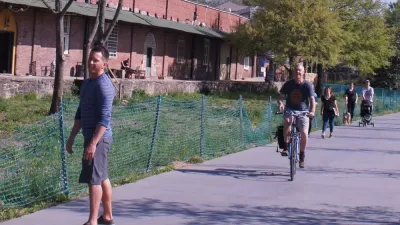While the neighborhoods on northern segments of the Atlanta's BeltLine has received 94 percent of funding invested towards parks and trails, segments to the south have received 86 percent of affordable housing investments.
A year-old report titled "An Atlanta BeltLine for All: Equitable Development Assessment" [pdf] was recently discussed on SaportaReport by David Pendered. The study was sponsored by the Atlanta BeltLine Partnership, funded by the Ford Foundation, and conducted by Nexus Research Group and Davidson Consulting. According to Pendered, "the Atlanta City Council created the plan in 2008, after public outcry over three significant acquisitions for the BeltLine in and adjacent to northeast Atlanta."
The findings of the report discuss resource allocation and investments made in the trails, parks, general corridor, and affordable housing within the five quadrants of the 22-mile BeltLine project, among other things. In the context of investment, Pendered highlights how "the BeltLine’s southwest area has received 5.5 percent of the total funds invested in BeltLine parks and trails, according to figures in the report. The actual investment is $7 million out of a total investment, as of the date of the report, of $126.8 million."
In addition, there is a vast difference between investment in affordable housing and investment in trails. Of the total $19.2 million invested in trails, "$12.9 million has been invested in the northeast and northside study areas and $6.3 million has been invested in southwest and southeast Atlanta." Indeed, most of the affordable housing is clustered in these southeast and southwest quadrants, 117 units have been funded there out of the total 131 at the time of the report's creation.
Much of the BeltLine's rhetoric has described it as a way to address the historic inequalities that exist in Atlanta along race and class lines.
FULL STORY: Atlanta BeltLine: North gets parks, trails; South gets affordable housing, according to little known report

Alabama: Trump Terminates Settlements for Black Communities Harmed By Raw Sewage
Trump deemed the landmark civil rights agreement “illegal DEI and environmental justice policy.”

Study: Maui’s Plan to Convert Vacation Rentals to Long-Term Housing Could Cause Nearly $1 Billion Economic Loss
The plan would reduce visitor accommodation by 25% resulting in 1,900 jobs lost.

Why Should We Subsidize Public Transportation?
Many public transit agencies face financial stress due to rising costs, declining fare revenue, and declining subsidies. Transit advocates must provide a strong business case for increasing public transit funding.

Wind Energy on the Rise Despite Federal Policy Reversal
The Trump administration is revoking federal support for renewable energy, but demand for new projects continues unabated.

Passengers Flock to Caltrain After Electrification
The new electric trains are running faster and more reliably, leading to strong ridership growth on the Bay Area rail system.

Texas Churches Rally Behind ‘Yes in God’s Back Yard’ Legislation
Religious leaders want the state to reduce zoning regulations to streamline leasing church-owned land to housing developers.
Urban Design for Planners 1: Software Tools
This six-course series explores essential urban design concepts using open source software and equips planners with the tools they need to participate fully in the urban design process.
Planning for Universal Design
Learn the tools for implementing Universal Design in planning regulations.
Caltrans
Smith Gee Studio
Institute for Housing and Urban Development Studies (IHS)
City of Grandview
Harvard GSD Executive Education
Toledo-Lucas County Plan Commissions
Salt Lake City
NYU Wagner Graduate School of Public Service




























